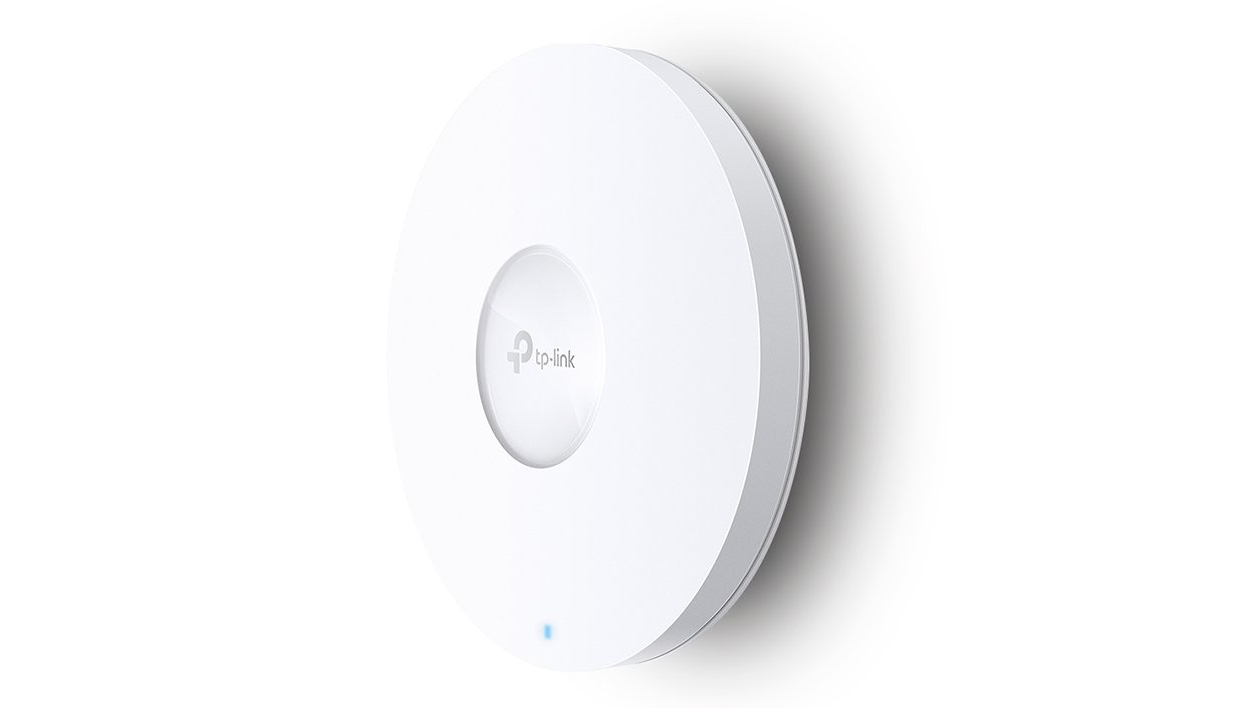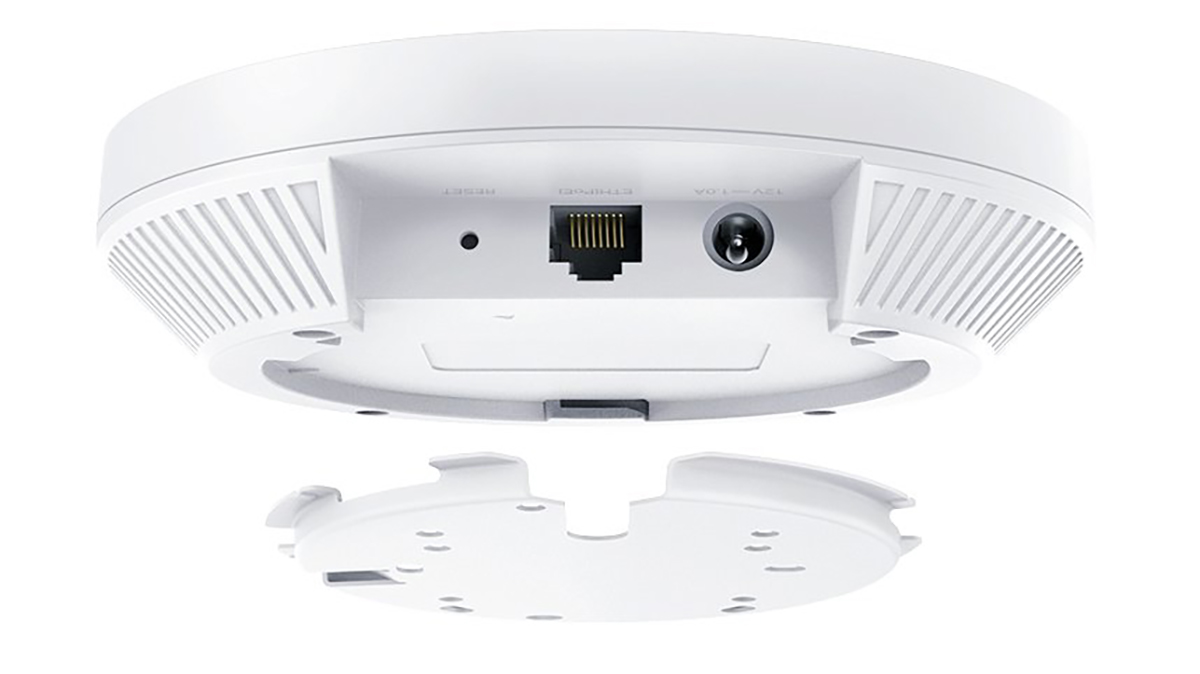TP-Link Omada EAP650 review: An impressive Gigabit performer
A great-value Wi-Fi 6 AP with a good turn of speed, top cloud management and meshing support


-
+
Strong Gigabit performance
-
+
Strong mesh support
-
+
Simple cloud management
-
+
Excellent value
-
-
No 2.5GbE Ethernet port

SMBs that want an affordable and compact Wi-Fi 6 access point (AP) with an emphasis on speed will appreciate TP-Link’s Omada EAP650. Costing only £139, this slimline ceiling-mount AP isn’t much larger than a smoke detector and yet combines a fast AX3000 rating with support for the Wi-Fi 6 high-performance 160MHz channels.
The EAP650 delivers speeds of up to 2,402Mbits/sec on its 5GHz radio and 574Mbits/sec on the 2.4GHz one. Its single LAN port supports PoE+, but if you don’t have an available power source, the box includes an external PSU as well. The only catch is that the port is the Gigabit variety, so you won’t see the full potential of the 160MHz channels.
On the plus side, the EAP650 teams up plenty of business-class features with two management choices. You can use it in standalone mode, but most businesses will prefer TP-Link’s Omada cloud service, as they can manage multiple sites, all associated APs and other Omada-enabled switches and routers from one web portal. Each site requires an Omada cloud controller, and TP-Link offers free software versions for Windows and Linux that support up to 1,500 managed devices.
For testing, we used the lab’s OC300 hardware appliance, which runs the Linux controller version, supports 700 devices and costs around £100. For the complete Omada experience, we added TP-Link’s TL-R605 broadband router, which costs £40 and powered the EAP650 with a TL-SG3210XHP-M2 PoE+ multi-gigabit switch, which adds £286 to the bill.
Once the EAP650 was powered and connected, it appeared in our cloud portal as “pending” and, when it was adopted, it pulled all its settings from the controller and broadcast our predefined site SSIDs. You can create the same number of SSIDs as in standalone mode – up to eight per radio – and apply mixed mode WPA2/WPA3 encryption, rate limits and load balancing.

The portal brings meshing into play, where a wired AP functions as the root and other compliant APs connect to it using their 5GHz radio as a backhaul. You can spread your wireless network far and wide, as mesh APs can connect to other nodes with up to three hops between them and the root AP.
To test meshing, we placed a TP-Link EAP620 HD near to the EAP650 with power provided but no wired network connection. It appeared in the portal as pending, with an extra icon showing a wireless link to the root AP, and adopting it instantly created a mesh network allowing users to roam seamlessly across all member APs.
Sign up today and you will receive a free copy of our Future Focus 2025 report - the leading guidance on AI, cybersecurity and other IT challenges as per 700+ senior executives
The cloud portal also delivers classy captive portal features for managing guest wireless access. Authentication methods include password, local user, voucher, Radius, Facebook or SMS using the paid-for service, plus you can add your own background pictures and brand logos, enforce acceptable use policies (AUPs), cycle through up to five advertising images and present PC and mobile-friendly portal versions.
For our real-world performance tests, we used a Dell Windows 10 Pro workstation equipped with a TP-Link Archer TX3000E Wi-Fi 6 PCI-E adapter, which employs an Intel AX200 chip supporting all Wi-Fi 6 channels. With the AP’s 80MHz channels enabled from the cloud portal, close-range copies of a 25GB test file between the workstation and a server on our 10GbE LAN averaged an impressive 109MB/sec. This dipped to 97MB/sec with the AP ten metres away.
With the AP’s 160MHz channels activated, the workstation reported a 2.4Gbits/sec wireless connection. Unsurprisingly, our file copies maxed out the AP’s gigabit port and only increased to 113MB/sec at close range and 111MB/sec at ten metres.
It’s a shame the EAP650 isn’t endowed with a 2.5GbE LAN port, but it still delivers impressive performance over Gigabit that will satisfy all but the most demanding of environments. It offers plenty of wireless features, including meshing, all easily managed from the Omada cloud portal, and for an AX3000-rated Wi-Fi 6 AP, it’s great value as well.
TP-Link Omada EAP650 specifications
| Band support | AX3000 dual-band 2.4GHz/5GHz 802.11ax |
| Radios | 2 x dual-band internal aerials |
| Ports | Gigabit LAN/802.3at PoE+ |
| Additional features | Ceiling mount plate, power adapter included |
| Dimensions (WDH) | 160 x 160 x 34mm |
| Weight | 395g |
Dave is an IT consultant and freelance journalist specialising in hands-on reviews of computer networking products covering all market sectors from small businesses to enterprises. Founder of Binary Testing Ltd – the UK’s premier independent network testing laboratory - Dave has over 45 years of experience in the IT industry.
Dave has produced many thousands of in-depth business networking product reviews from his lab which have been reproduced globally. Writing for ITPro and its sister title, PC Pro, he covers all areas of business IT infrastructure, including servers, storage, network security, data protection, cloud, infrastructure and services.
-
 ‘1 engineer, 1 month, 1 million lines of code’: Microsoft wants to replace C and C++ code with Rust by 2030 – but a senior engineer insists the company has no plans on using AI to rewrite Windows source code
‘1 engineer, 1 month, 1 million lines of code’: Microsoft wants to replace C and C++ code with Rust by 2030 – but a senior engineer insists the company has no plans on using AI to rewrite Windows source codeNews Windows won’t be rewritten in Rust using AI, according to a senior Microsoft engineer, but the company still has bold plans for embracing the popular programming language
By Ross Kelly Published
-
 Google drops $4.75bn on data center and energy firm Intersect
Google drops $4.75bn on data center and energy firm IntersectNews The investment marks the latest move from Google to boost its infrastructure sustainability credentials
By Nicole Kobie Published
-
 OpenAI says prompt injection attacks are a serious threat for AI browsers – and it’s a problem that’s ‘unlikely to ever be fully solved'
OpenAI says prompt injection attacks are a serious threat for AI browsers – and it’s a problem that’s ‘unlikely to ever be fully solved'News OpenAI details efforts to protect ChatGPT Atlas against prompt injection attacks
By Nicole Kobie Published
